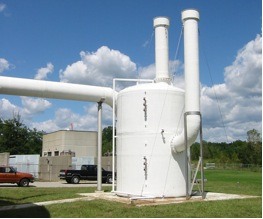Carbon Adsorbers
Carbon adsorbers, biofilters and bioscrubbers are the most popular odor control technologies in municipal wastewater. Activated carbon has a complex pore structure with a very large surface area. Odorous compounds are transferred from the air being treated to the surface of the carbon as the air is forced through the carbon bed. There is a physical attraction between the compound and the carbon once contact is made which causes a bonding. The compounds will continue to adsorb onto the surface of the carbon until all the pore space in the carbon is used up. When that happens odorous compounds will breakthrough and the carbon must be replaced or regenerated.
Carbon adsorbers are typically used for air streams with relatively low hydrogen sulfide (H2S) concentrations (<15 ppm). They may be used for higher concentrations but the cost of replacement carbon often makes other treatment options like biofilters and bioscrubbers more cost effective at that point. Carbon may be used either for primary odor control or as a polishing stage following a chemical scrubber or biological treatment system.
Carbon Adsorber
Carbon adsorbers typically include fiberglass vessels, which house carbon between perforated plates. The dual-bed adsorber shown in the above picture has two 3 ft. deep beds of carbon. 50% of the air goes through the top bed and the rest goes through the bottom bed. This is often done to reduce the footprint and diameter of the vessel. Other vessel designs include vertical bed units and radial flow units. The radial flow design will likely become the most popular design in years to come. These systems are easy to design, operate and maintain. Aside from the exhaust fan, there are essentially no moving parts and very few instruments.
There are many types of carbon available depending on the compounds to be removed. Coconut shell based granular activated carbon is typically used in applications that require VOC removal and have low levels of H2S. Bituminous coal based catalytic carbon is specifically manufactured to have a high capacity for H2S and is often used in wastewater treatment applications. Caustic impregnated carbon also has a high capacity for H2S but this is now rarely used due to the hazards associated with the impregnation and the development of the catalytic carbons.
Advantages
The advantages of carbon adsorbers include:
- Typically low capital cost compared to alternatives alternative
- Easy to install and maintain. Requires almost no operator attention until carbon needs to be replaced
- Require no chemical storage or handling
- Require a relatively small footprint
- Require few moving parts
- Typically provide hydrogen sulfide removal efficiencies greater than 99%.
- Provide excellent removal of volatile organic compounds.
- Carbon works well in remote locations where there is no water supply, such as pumping station wet wells
- Works well as a polishing stage.
Disadvantages
The disadvantages of carbon adsorption are:
- Carbon replacement costs can be high when inlet loadings are high, especially when inlet H2S is high.
- Catalytic carbons will convert mercaptans to dimethyl disulfide, which is also very odorous. Catalytic carbon should not be used in applications with high methyl mercaptans.
- Carbon disposal can also be an issue if it is contaminated by compounds in the air stream being treated or if it is impregnated. However, in most cases the spent carbon can be taken to a standard landfill.
- Carbon works best when treating air with a moisture content of 50% or less. The moisture can be adsorbed into pore spaces reducing capacity of the carbon. Grease and water droplet filters typically precede carbon adsorbers to improve performance.
Applicable Treatment Processes
All liquid treatment plant processes, pump stations, sludge thickening, sludge dewatering.
Major Design Considerations
Carbon selection
The type of carbon should be selected based on the individual application, contaminant compounds in the air and compound concentrations. Two or three different types of carbon can be used in layers within the vessel if there is a need to remove multiple compounds.
Carbon bed depth
Bed depth is dependent on odorous compound concentrations but 3 feet is typical. Dual beds may be designed for higher air flows where there are site size restrictions.

